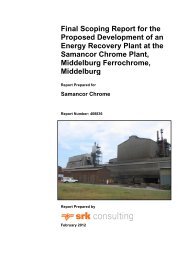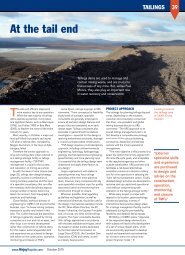Draft Status Quo Report for the Pixley Ka Seme ... - SRK Consulting
Draft Status Quo Report for the Pixley Ka Seme ... - SRK Consulting
Draft Status Quo Report for the Pixley Ka Seme ... - SRK Consulting
Create successful ePaper yourself
Turn your PDF publications into a flip-book with our unique Google optimized e-Paper software.
<strong>SRK</strong> <strong>Consulting</strong> in association with BKS<br />
<strong>Pixley</strong> <strong>Ka</strong> <strong>Seme</strong> Local Municipality EMF – <strong>Draft</strong> <strong>Status</strong> <strong>Quo</strong> <strong>Report</strong> Page 42<br />
• The demarcation of <strong>the</strong> eastern portion of <strong>the</strong><br />
municipality as a service upgrading priority area,<br />
including <strong>the</strong> settlements of Wakkerstroom and<br />
Daggakraal.<br />
<strong>Pixley</strong> <strong>Ka</strong> <strong>Seme</strong> Local Municipality<br />
The PKSLM IDP (2009-2012) aims <strong>for</strong> “comprehensive<br />
integrated planning and economic development”.<br />
According to <strong>the</strong> IDP, <strong>the</strong> municipality will focus on<br />
addressing <strong>the</strong> community needs, improve service<br />
deliver and creating jobs, meeting <strong>the</strong> millennium goals,<br />
improving communication and community<br />
participation. Strategies developed to give effect to <strong>the</strong><br />
IDP intend to, amongst o<strong>the</strong>rs:<br />
• “Move faster and fur<strong>the</strong>r in providing <strong>the</strong> better life<br />
<strong>for</strong> all;<br />
• Halve unemployment and poverty by 2014;<br />
• Provide <strong>the</strong> skills required by <strong>the</strong> district <strong>for</strong><br />
economic development and growth;<br />
• Working with our National and Provincial<br />
Governments to improve service delivery and<br />
access to basic services;<br />
• Ensure participation of <strong>the</strong> people to allow citizens<br />
to identify <strong>the</strong> problems that <strong>the</strong>ir community face<br />
and partner in providing solutions to deal with <strong>the</strong>se<br />
problems and improve public service;<br />
• Speed up <strong>the</strong> delivery of free basic services;<br />
• Build sustainable human settlements and viable<br />
communities;<br />
• Provide infrastructure that will create an<br />
environment that is conducive to economic growth<br />
and development that facilitate and increase<br />
capacity to provide basic services, which will<br />
contribute to a safe and healthy environment; and<br />
• Create job opportunities and fight poverty through<br />
infrastructure development and service delivery,<br />
procurement and support <strong>for</strong> SMME’s and Broad<br />
Based Black Economic Development.”<br />
community participation, trained and motivated<br />
staff, rapid economic development and a<br />
tourism friendly environment”.<br />
3.5 Socio-economic<br />
The Socio-economic specialist report <strong>for</strong> <strong>the</strong> PKSLM<br />
(BKS, 2010) provides an overview of <strong>the</strong> study area,<br />
key aspects of which are summarized below. Statistics<br />
in this report were primarily taken from <strong>the</strong> StatsSA<br />
Community Survey conducted in 2007. It needs to be<br />
highlighted that population figures in <strong>the</strong> various<br />
reports studied varied greatly from a net decrease in<br />
population to a net increase in population. For<br />
consistency purposes, <strong>the</strong> Stats SA Community Survey<br />
(CS) data (Stats SA, 2007) covers all statistics required<br />
<strong>for</strong> this study, <strong>the</strong>re<strong>for</strong>e was used throughout <strong>the</strong> report.<br />
With all statistical data <strong>the</strong>re is a level of uncertainty<br />
and unlike <strong>the</strong> o<strong>the</strong>r available datasets <strong>the</strong> StatsSA<br />
(2007) CS data has documented possible<br />
irregularities and inconsistencies which have been<br />
summarised in <strong>the</strong> Socio-economic specialist report<br />
(Van Niekerk et al., 2010).<br />
3.5.1 Population size and distribution<br />
The Province is home to approximately 3.1 million<br />
people (see Table 3-11). This figure translates to a<br />
10.3% increase from approximately 2.8 million people<br />
in 1996. The current situation, according to Stats SA<br />
(2007), estimates <strong>the</strong> population to be at 3.6 million<br />
people (see Table 3-12). This translates to a 16.6%<br />
increase from 2001, approximately 3.3% per year over a<br />
period of five years.<br />
Table 3-11: Population size and growth<br />
Census<br />
2001<br />
CS 2007<br />
%<br />
Increase/<br />
decrease<br />
% GSDM<br />
population<br />
(2007)<br />
MP 3,122,990 3,643,435 16.6 100.0<br />
GS DM 900,011 890,700 -1.0 24.4<br />
PKSLM 80,737 65,932 -18.3 18.0<br />
Source: StatsSA, (2001 & 2007)<br />
• The PKSLM SDF 2009 which provides <strong>for</strong> <strong>the</strong><br />
spatial context <strong>for</strong> <strong>the</strong> IDP, aims <strong>for</strong> “cost<br />
effective and efficient service delivery which<br />
must be underpinned by good planning and a<br />
proper integrated plan … achieved through<br />
KILI/BEAT G:\404946_PIXLEY EMF\7REPORTS\<strong>Status</strong> <strong>Quo</strong> report\<strong>Draft</strong> report\<strong>Draft</strong> status quo report, July 2010.docx July 2010









